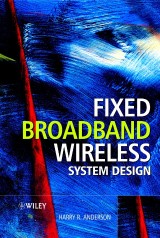Details

Fixed Broadband Wireless System Design
1. Aufl.
|
156,99 € |
|
| Verlag: | Wiley |
| Format: | |
| Veröffentl.: | 25.07.2003 |
| ISBN/EAN: | 9780470861288 |
| Sprache: | englisch |
| Anzahl Seiten: | 512 |
DRM-geschütztes eBook, Sie benötigen z.B. Adobe Digital Editions und eine Adobe ID zum Lesen.
Beschreibungen
Fixed broadband networks can provide far higher data rates and capacity than the currently envisioned 3G and 4G mobile cellular systems. Achieving higher data rates is due to the unique technical properties of fixed systems, in particular, the use of high gain and adaptive antennas, wide frequency bands, dynamic data rate and channel resource allocation, and advanced multiple access techniques. <p><i>Fixed Broadband Wireless System Design</i> is a comprehensive presentation of the engineering principles, advanced engineering techniques, and practical design methods for planning and deploying fixed wireless systems, including:</p> <ul> <li>Point-to-point LOS and NLOS network design</li> <li>Point-to-point microwave link design including active and passive repeaters</li> <li>Consecutive point and mesh network planning</li> <li>Advanced empirical and physical propagation modeling including ray-tracing</li> <li>Detailed microwave fading models for multipath and rain</li> <li>NLOS (indoor and outdoor) propagation and fading models</li> <li>Propagation environment models including terrain, morphology, buildings, and atmospheric effects</li> <li>Novel mixed application packet traffic modeling for dimensioning network capacity</li> <li>Narrow beam, wide beam, and adaptive (smart) antennas</li> <li>MIMO systems and space-time coding</li> <li>Channel planning including fixed and dynamic channel assignment and dynamic packet assignment</li> <li>IEEE 802.11b and 802.11a (WLAN) system design</li> <li>Free space optic (FSO) link design</li> </ul> <p>At present, there are no titles available that provide such a concise presentation of the wide variety of systems, frequency bands, multiple access techniques, and other factors that distinguish fixed wireless systems from mobile wireless systems. <i>Fixed Broadband Wireless System Design</i> is essential reading for design, system and RF engineers involved in the design and deployment of fixed broadband wireless systems, fixed wireless equipment vendors, and academics and postgraduate students in the field.</p>
Preface. <p>Fixed Broadband Wireless Systems.</p> <p>Electromagnetic Wave Propagation.</p> <p>Propagation and Channel Modes.</p> <p>Fading Models.</p> <p>Propagation Environment Models.</p> <p>Fixed Wireless Antenna Systems.</p> <p>Modulation, Equalizers, and Coding.</p> <p>Multiple-Access Techniques.</p> <p>Traffic and Application Mix Models.</p> <p>Single and Multilink System Design.</p> <p>Point-to-Multipoint (PMP) Network Design.</p> <p>Channel Assignment Strategies.</p> <p>Appendix A: Atmospheric and Rain Data.</p> <p>Appendix B: PDF of a Signal with Interference and Noise.</p> <p>Index.</p>
<p><strong>Harry R. Anderson</strong> is the author of <em>Fixed Broadband Wireless System Design</em>, published by Wiley.
Fixed broadband wireless systems provide an alternative solution for the "last mile" delivery of high-speed Internet and other data services to businesses and homes. <p>Two-way wireless connections can be deployed more rapidly and less expensively than traditional optical fiber, coaxial cable, or wired telephone connections. Fixed broadband networks can also provide much higher data rates and capacity than the currently envisioned 3G and 4G cellular systems. Achieving these higher data rates and capacity is a result of the unique technical properties of fixed wireless systems, in particular, the use of high gain directional antennas, wide frequency bands, dynamic data rate allocation, and advanced multiple access techniques.</p> <ul> <li>Provides a comprehensive discussion of the fundamental elements of fixed</li> <li>Details the technologies that are currently being developed or deployed for fixed broadband wireless communications including W-CDMA.OFDM, FDD/TDD, MIMO, smart antennas, free space optics (FSO), Wi-Fi and more</li> <li>Features in-depth explanations of fixed wireless network design techniques for point-to-point (PTP) microwave links and point-to-multipoint (PMP) networks, as well as strategies for optimum channel planning and network layout</li> <li>Describes practical system design methods using the most advanced propagation and fading models for line-of-sight (LOS) and non-line-of-sight (NLOS) networks operating in urban, suburban and rural environments</li> <li>Includes new research results for modeling mixed-application packet traffic capacity demands in multipoint networks</li> </ul> <p>Based on the author's wealth of research and industrial experience, this volume will be extremely useful and informative for RF engineers currently involved in the development, design and deployment of fixed broadband wireless systems. It will also be a valuable reference for technical managers, equipment suppliers, academics and postgraduate students.</p>


















